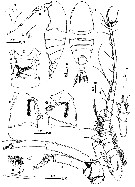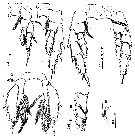|
|
 |
Fiche d'espèce de Copépode |
|
|
Calanoida ( Ordre ) |
|
|
|
Arietelloidea ( Superfamille ) |
|
|
|
Arietellidae ( Famille ) |
|
|
|
Sarsarietellus ( Genre ) |
|
|
| |
Sarsarietellus suluensis Ohtsuka, Nishida & Machida, 2005 (F) | |
| | | | | | | Ref.: | | | Ohtsuka & al., 2005 (p.2504, Descr.F, figs.F) |  issued from : S. Ohtsuka, S. Nishida & R.J. Machida in J. Nat. Hist., 2005, 39 (27). [p.2505, Fig.11]. Female (from Sulu Sea): A-B, habitus (lateral anr dorsal, respectively); C, anterolateral papilla of cephalosome (arrowed in fig.A); D, rostrum (anterior) (filaments missing); E, genital double-somite (ventral); F-G, idem (right lateral and left lateral, respectively); H, A1; I, terminal segments of A1; J, A2; K, Md (mandibular cutting edge). Scale bars in mm. Nota: Cephalosome with round papilla anterolaterally at each side. Rostrum possibly with pair of filaments (missing). Prosome about 3.1 times as long as urosome; prosomal end asymmetrical, with right side more produced outward; dorsolateral and ventrolateral processes acutely pointed. Urosome 4-segmented. Genital double-somite slightly asymmetrical from dorsal view, but highly from ventral view; genital system remarkably asymmetrical, with right gonopore larger and more anteriorly located than left one; copulatory pore opening beneath irregular ventral protrusion on right side; copulatory duct heavily chitinized, Y-shaped; seminal receptacle tubular, terminating at round tip, about half as long as genital double-somite. Anal somite short. Caudal rami symmetrical, ornamented with fine setules along inner margin; seta I rudimentary, seta IV thickest (terminal part missing). A1 symmetrical, 23-segmented, reaching posterior margin of pediger 3; 1st (ancestral I-III) to 8 (ancestral X) segments fringed with long setules along posterior margin. A2 with unarmed coxa; basis with serrate seta at inner corner; endopod 2-segmented, 1st segment with minute seta distally, 2nd segment with 3 inner setae of unequal length and 1 reduced and 5 ordinary terminal setae; exopod indistinctly 8-segmented, setal formula 0, 1, 1, 1, 1, 1, 0, 3 (1 vestigial).
|
 issued from : S. Ohtsuka, S. Nishida & R.J. Machida in J. Nat. Hist., 2005, 39 (27). [p.2506, Fig.12]. Female: A, Md (mandibular palp; phoront of apostome ciliate (?) indicated by arrowed); B, phoront of apostome ciliate (?) on mandibular palp; C, Mx1; D, Mx2; E, basal spine of Mx2; F, Mxp (some setae omitted); G, 4th endopodal segment of Mxp (only smallest seta illustrated); H, 5th endopodal segment of Mxp (largest seta omitted). Scale bars in mm. Nota: Md with 2 mono- and 1 bicuspid teeth and 2 patches of setules along cutting edge; patch of long setules present near base of palp (not shown in fig.11K); endopod 1-segmented, with 1 well-developed and 1 rudimentary seta; exopod 5-segmented, setal formula 1, 1, 1, 1, 2. Mx1 with praecoxal arthrite bearing 5 naked spines, 1 process and patch of long spinules; coxal endite bearing serrate seta; coxal epipodite with 8 setae; basis with 2 rows of long setules and 1 vestigial seta; endopod 1-segmented, bulbous, with 2 serrate unequal setae terminally; exopod 1-segmented, lobate, with 3 long setae (1 missing in figure 12C) terminally. Mx2 with 1st praecoxal endite bearing 2 setae and 1 vestigial element; 2nd praecoxal to 2nd coxal endites each with 2 serrate setae; basis elongated, bearing relatively short spine with 2 longitudinal rows of fine setules; endopod indistinctly 4-segmented, with setal formula 1, 3, 2, 2. Mxp with syncoxa bearing 1 middle and 2 subterminal serrate setae and patch of fine spinules; basis protruded midway, with 2 serrate setae and patch of fine spinules; 1st endopodal segment nearly incorporated into basis, with serrate seta; 2nd to 5th endopodal segments bearing 4, 4, 3, and 3 setae, respectively; 2nd endopodal segment elongate; terminal endopodal segment with reduced seta a and long seta b (fig.12H)
|
 issued from : S. Ohtsuka, S. Nishida & R.J. Machida in J. Nat. Hist., 2005, 39 (27). [p.2507, Fig.13]. Female: A, P1 (anterior); B, endopod of P1 (anterior); C, P2 (anterior); D, outer distal corner of 2nd endopodal segment of P2; E, P3 (anterior); F, P4 (posterior); G, P5 (posterior). Scale bars in mm. Nota: P5 almost symmetrical, with coxae and intercoxal sclerite completely fused to form common base; basis bearing plumose seta near outer middle margin on posterior surface; endopod represented by process carrying 4 plumose setae, acutely pointed at tip; exopod 1-segmented, with 1 long, terminal and 4 short, outer spines; terminal right process of exopod slightly longer than left one.
| | | | | NZ: | 1 | | |
|
Carte de distribution de Sarsarietellus suluensis par zones géographiques
|
| | | | Loc: | | | Sulu Sea (central)
Type locality: 08°57.31'N, 120°11.31'E. | | | | N: | 1 | | | | Lg.: | | | (983) F: 3,08; {F: 3,08} | | | | Rem.: | hyperbenthic (1516 m). | | | Dernière mise à jour : 31/01/2015 | |
|
|
 Toute utilisation de ce site pour une publication sera mentionnée avec la référence suivante : Toute utilisation de ce site pour une publication sera mentionnée avec la référence suivante :
Razouls C., Desreumaux N., Kouwenberg J. et de Bovée F., 2005-2025. - Biodiversité des Copépodes planctoniques marins (morphologie, répartition géographique et données biologiques). Sorbonne Université, CNRS. Disponible sur http://copepodes.obs-banyuls.fr [Accédé le 29 décembre 2025] © copyright 2005-2025 Sorbonne Université, CNRS
|
|
 |
 |






